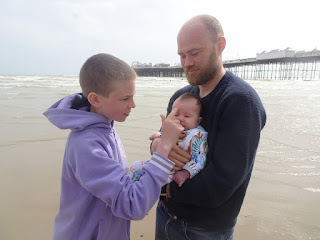It is 110 years since Eric Cyril Egerton Leadbitter published his first novel, Rain Before Seven, partially set in Brighton where the ‘dazzling sea [. . .] tumbles in white foam over the shingle’ and where the sea can be ‘washed [. . .] to the faintest and purest blue’. Little seems to be remembered of Leadbitter, though he seems to have abandoned a promising literary talent for a career in the civil service.
He was born in 1891, possibly in Hexham, and educated at Shrewsbury, but his early life and education are otherwise barely documented in public records. He began a literary career during World War I, publishing a series of novels that reflected the themes and styles of his era:
Rain Before Seven (1915),
The Road to Nowhere (1916),
Perpetual Fires (1918),
Shepherd’s Warning (1921),
Dead Reckoning (1922), and
The Evil that Men Do (1923).
Wikipedia lists only these six novels for him, and, similarly, the
British Library catalogue has only these same six titles.
Thereafter, Leadbitter built a distinguished career in the British civil service. Who Was Who lists Tunbridge Wells as his place of residence. In 1937, he was appointed Commander of the Royal Victorian Order (CVO), an honour recognising his service to the Crown. His most significant administrative role came in 1942, when he was appointed Clerk of the Privy Council, a senior position he held until 1951. During his tenure, he was knighted as a Knight Bachelor in 1946 and, in 1951, was promoted to Knight Commander of the Royal Victorian Order (KCVO), reflecting the high regard in which he was held within government circles.
On the personal front, Leadbitter married Irene Lloyd in 1918, though there seems to be no public information regarding his family life and whether he had children. He died in 1971.
Rain Before Seven was first published in 1915 by G. Allen & Unwin. The story follows a young boy named Michael as he prepares to leave home for the first time. The narrative explores Michael’s emotions and experiences leading up to his departure, including his relationships with family members, his imagination, and his fears about the future. The book is divided into three parts: The Idle Apprentice, Obscurity and Enlightenment, and the US edition (1920) can be freely read online at Internet Archive. Incidentally, several books with the same title have appeared over the years, most likely because of the popularity of the traditional weather lore ‘Rain before seven, fine before eleven’.
The following extract about Brighton is taken from Leadbitter’s Rain Before Seven, chapter XXVI entitled The Prodigal Brother.

‘Brighton is a most deceptive town; the hints that it gives of its past are as little to be relied upon as those of certain of its lady visitors when they are in reminiscent mood. To a visitor who is enterprising enough to explore them, the little by-streets that lead from the Western Road appear to belong to a past when the town slept the sleep of gentle Georgian cathedral cities, untainted by the neighbouring metropolis. There are strangely huddled little houses that might date from an innocent youth that touched hands with the medievals. Nevertheless, as every Londoner and many natives know, a century ago nothing except a fishing village lay at the foot of the cliffs where Brighton with her flaunting pride now stands. Evil fairies attended her christening; George of ill-repute was her sponsor, and she has never thrown off the shadow of her early influences. Brighton with all her witchery is the British Paris; she is the pleasure suburb where Londoners pursue their vices in secrecy. But who can resist the witchery of the air? the dry and sunny wind, and the dazzling sea that tumbles in white foam over the shingle? Not, at any rate, a group of young people who were passing along the front one sunny April morning, a year later than the events recorded in the last chapter, with the brisk and ecstatic walk that vouches for an early bathe behind, and a voracious appetite for a breakfast to come. The previous day had been stormy, and mists of rain had washed the sea to the faintest and purest blue. On the foreshore, a few figures were bending over the pebbles, searching for the small treasures that a heavy sea like that of the preceding day usually unearthed. The party on the promenade stopped to watch them, and one of the girls asked her companion what they were doing.
“I don’t know much about it,” he replied, “but I have an idea they are called beach-combers, or something. They rake up old sixpences and things among the stones.”
“How exciting! I suppose they are always hoping to find a wonderful buried treasure. Rosie!” she called to an older girl who was behind her, “what do you say to having a shot at it?” ’
[NB: The portrait of Leadbitter has been screenshot from the National Portrait Gallery website.]














